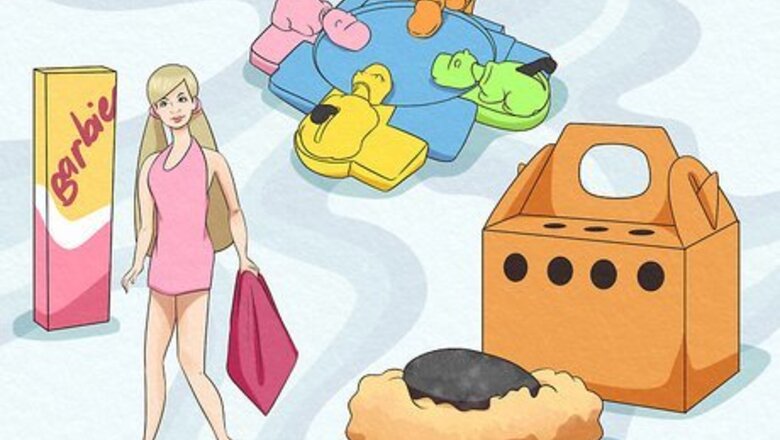
views
In Music
Listen to early 1970s music. Eventually, hard rock and soft rock rose in popularity. R&B was a popular genre in the early 1970s. Also, many prominent musicians from earlier decades passed in the early 1970s, such as Jim Morrison, Janis Joplin and Jimi Hendrix. Popular artists include Aerosmith, The Carpenters, Chicago, Elton John, Eric Clapton, the Jackson 5, Led Zeppelin, the Rolling Stones, and Stevie Wonder. 1970 songs: "Ain't No Mountain High Enough" by Diana Ross, "Bridge Over Troubled Water" by Simon and Garfunkel, "I'll Be There" by The Jackson 5, "Let It Be" by The Beatles, "Lookin' out My Back Door" by Creedence Clearwater Revival, "Raindrops Keep Fallin' On My Head" by B.J. Thomas, "(They Long to Be) Close to You" by The Carpenters, "Venus" by Shocking Blue, "War" by Edwin Starr, etc. 1971 songs: "Ain’t No Sunshine" by Bill Withers, "Brown Sugar" by The Rolling Stones, "Family Affair" by Sly and the Family Stone, "How Can You Mend a Broken Heart?" by The Bee Gees, "Imagine" by John Lennon, "Joy to the World" by Three Dog Night, "One Bad Apple" by The Osmonds, "Take Me Home, Country Roads" by John Denver, "What's Going On" by Marvin Gaye, "Your Song" by Elton John, "You’ve Got a Friend" by Carole King, etc. 1972 songs: "American Pie" by Don McLean, "Ben" by Michael Jackson, "Brandy (You're a Fine Girl)" by Looking Glass, "Changes" by David Bowie, "Lean on Me" by Bill Withers, "My Ding-A-Ling" by Chuck Berry, "Papa Was a Rolling Stone" by the Temptations, "Rocket Man (I Think It's Going to Be a Long Long Time)" by Elton John, "Smoke on the Water" by Deep Purple, "Superstition" by Stevie Wonder, "Take It Easy" by the Eagles, etc. 1973 songs: "Angie" by the Rolling Stones, "Bad, Bad Leroy Brown" by Jim Croce, "Crocodile Rock" by Elton John, "Dream On" by Aerosmith, "Jolene" by Dolly Parton, "Killing Me Softly With His Song" by Roberta Flack, "Let's Get It On" by Marvin Gaye, "Midnight Train to Georgia" by Gladys Knight & the Pips, "Tie a Yellow Ribbon Round the Ole Oak Tree" by Tony Orlando and Dawn, "Touch Me In the Morning" by Diana Ross, etc.
Listen to mid-1970s music. Punk music started to grow in popularity, with bands such as The Ramones, Patti Smith, and Blondie forming. Country music also gained more listeners. A mixture of country and blues music emerged in the mid-1970s, as well as country pop. Popular artists include ABBA, Cher, Chicago, David Bowie, Fleetwood Mac, Lynyrd Skynyrd, The Righteous Brothers, The Who, Rod Stewart, Wings, etc. 1974 songs: "Bennie and the Jets" by Elton John, "Come and Get Your Love" by Redbone, "Dark Lady" by Cher, "Help Me" by Joni Mitchell, "Hooked on a Feeling" by Blue Swede, "Killer Queen" by Queen, "Love's Theme" by Love Unlimited Orchestra, "Spiders and Snakes" by Jim Stafford, "Sweet Home Alabama" by Lynyrd Skynyrd, "The Way We Were" by Barbra Streisand, "Waterloo" by ABBA, etc. 1975 songs: "Bohemian Rhapsody" by Queen, "Fame" by David Bowie, "Kung Fu Fighting" by Carl Douglas, "Lady Marmalade" by Labelle, "Landslide" by Fleetwood Mac, "Love Will Keep Us Together" by Captain & Tennille, "Mamma Mia" by ABBA, "Philadelphia Freedom" by Elton John, "Rhinestone Cowboy" by Glen Campbell, 1976 songs: "Dancing Queen" by ABBA, "Disco Lady" by Johnnie Taylor, "Don't Go Breaking My Heart" by Elton John and Kiki Dee, "I Write The Songs" by Barry Manilow, "Play That Funky Music" by Wild Cherry, "(Shake, Shake, Shake) Shake Your Booty" by K.C. and The Sunshine Band, "Silly Love Songs" by Paul McCartney and Wings, "Tonight's The Night (Gonna Be Alright)" by Rod Stewart, "You Should Be Dancing" by the Bee Gees, etc.
Listen to late 1970s songs. The late 1970s consisted mainly of disco and heavy metal. Glam rock was also a huge genre as the 1970s ended. Many of these artists were European, bringing in new sounds into music. New wave bands began experimenting with synthesizers to change up the sounds, which eventually led to the mid-1980s synth-pop era. Popular artists include ABBA, the Bee Gees, David Bowie, Olivia Newton-John, Pink Floyd, Queen, etc. 1977 songs: "Dreams" by Fleetwood Mac, "Hotel California" by the Eagles, "I Just Want to Be Your Everything" by Andy Gibb, "I'm Your Boogie Man" by K.C. and The Sunshine Band, "Love Theme (From "A Star Is Born")" by Barbra Streisand, "Margaritaville" by Jimmy Buffet, "Stayin' Alive" by the Bee Gees, "We Are the Champions" by Queen, "We Will Rock You" by Queen, etc. 1978 songs: "Copacabana" by Barry Manilow, "How Deep Is Your Love" by the Bee Gees, "Night Fever" by the Bee Gees, "Rasputin" by Boney M, "Shadow Dancing" by Andy Gibb, "Sultans of Swing" by Dire Straits, "You Light Up My Life" by Debby Boone, "You Make Me Feel (Mighty Real)" by Sylvester, "You're the One That I Want" by John Travolta and Olivia Newton-John, etc. 1979 songs: "Another Brick in the Wall (Pt 2)" by Pink Floyd, "Boogie Wonderland" by Earth, Wind and Fire, "Da Ya Think I'm Sexy?" by Rod Stewart, "Gimme! Gimme! Gimme! (A Man After Midnight)" by ABBA, "Heart of Glass" by Blondie, "Hot Stuff" by Donna Summer, "I Will Survive" by Gloria Gaynor, "Le Freak" by Chic, "My Sharona" by the Knack, "Video Killed the Radio Star" by the Buggles, "Y.M.C.A." by Village People, etc.
In Fashion
Find some 1970s fashion icons. Many of the people listed here were famous singers and actors that rose to fame in the 70s and 80s. Music, as well as political movements influenced many fashion styles of the 1970s. For example, the hippie look of the 1960s was still popular in the early 1970s. Search some of these up to gain some inspiration on your exact 1970s fashion style. Bianca Jagger Blondie Cher David Bowie Diana Ross Farrah Fawcett Marvin Gaye Mick Jagger Paul Newman Sophia Loren Stevie Nicks
Wear the hippie look. This look gained popularity in the 1960s, but stayed until the early 1970s. This became an important fashion statement in the 1970s, when people who weren't part of the hippie movement started wearing hippie-inspired clothing. Get floral-printed clothing, such as blouses. Wear long, flowy prairie dresses. Put on fringe vests. Wear peasant blouses.
Get the disco look of the 1970s. This is one of the most iconic looks of the 1970s. People usually think of the disco look when thinking about 1970s fashion. Find disco clothing and accessories to put together your disco-ready outfit. Try finding these in bold colors. Patterned disco outfits were also popular. Wear a disco shirt. A variety of shirts can be used for the disco look, such as a halterneck top or a peasant blouse. Get the bell-bottoms. Wear the jersey wrap dress. Diane von Fürstenberg popularized a version of the wrap dress in the 1970s.
Wear turtlenecks. These are a staple of the 1970s. Turtlenecks were worn with many different types of clothing, which made it a versatile choice in fashion. This piece of clothing helped make an androgynous look. Pair turtlenecks with bell-bottoms. Wear a matching plaid suit along with a turtleneck of a similar color. Put on a jumper dress over your turtleneck. Add tights or stockings of the same color as the turtleneck.
Wear heavy metal clothing. Music had a large influence on 1970s fashion. Heavy metal was one of the music genres that influenced the youth back then. Buy items like leather shirts, leather jackets, studded belts, and combat boots to complete your heavy metal look.
Wear glam rock clothing. Bands such as Kiss, Glade, and Sweet influenced the glam rock subculture and fashion. David Bowie was also a famous fashion icon known for his colorful, androgynous looks. Obtain clothing such as flared trousers, silk shirts, leather jackets, scarfs, spandex jumpsuits, and platform boots to complete the glam rock look.
In Toys, Games, and Shows
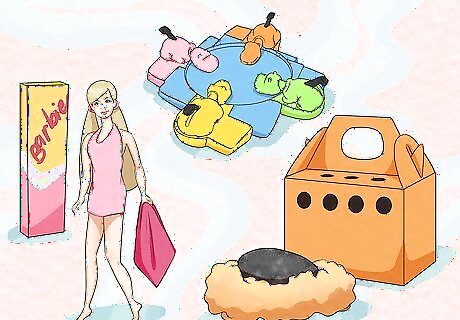
Find some 1970s toys. There were many iconic toys that symbolized the 70s decade. These classic toys looked quite different than their successors. For example, 1980s and 1990s Barbie dolls look quite different than the early 1960s and 1970s dolls. Ask someone from an older generation, such as your parents to see if they have these toys. Some of these toys might be unrecognizable to younger generations. Some of these include: 1970s Lego playsets (first released in 1932) View Master (released 1939) 1970s Barbie dolls, which had unrealistic bodies like a large bust, slightly curved arms, and a tiny waist (first released 1959) Lite Brite (released 1967) Big Wheel (released 1969) Nerf balls (released 1969) Weebles (released 1971) The original Baby Alive dolls (first released in 1973) Shrinky Dinks (1973) Rubik's Cube (released 1974) Pet rocks (brand made in 1975) The Six Million Dollar Man action figure (released 1975) Stretch Armstrong (released 1976) Hungry Hungry Hippos (released 1978) Simon (released 1978) Star Wars action figures (released 1978)
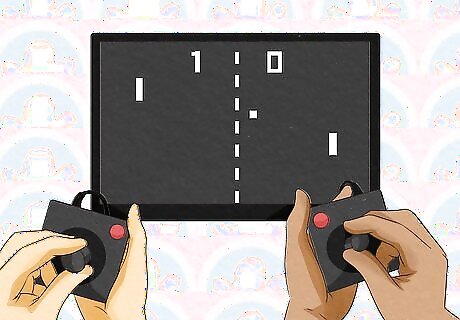
Play video games from the 1970s. The 1970s were the very beginning of modern video games. Many kids played these games in arcades instead of home consoles. These days, arcades have claw machines, air hockey tables, and cool 3D graphics on the arcade machine screens. In the 1970s, arcades were just full of arcade machines. Atari and Midway were popular console manufacturing companies. Even Nintendo was in its infancy in the 1970s. Midway and the original Atari company don't exist anymore, but they still made games that would kickstart the video game industry. You may have played some of these 1970s games. Computer Space (released 1971) The Oregon Trail (released 1971) Pong (released 1972) Tank (released 1974) Breakout (released 1976) Sea Wolf (released 1976) F-1 (released 1977) Space Invaders (released 1978)
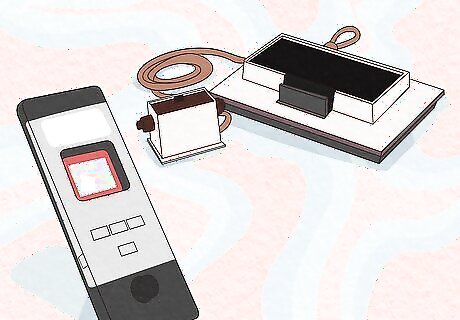
See if you have any 1970s video game consoles. Modern video game console developers like Microsoft didn't exist yet. Nintendo was in its infancy, and brands like Atari, Coleco, and Midway produced the first video game consoles. Not many people keep technology for 40-50 years, so it's ok if you don't have any of these consoles left. You could buy one at a store that sells vintage things, or you could just play the modern versions of the video games. Magnavox Odyssey - the first commercially available video game console (released in 1972 in the U.S., released in 1973 overseas) Fairchild Channel F (released 1976) Atari 2600 (released 1977) Color TV-Game - the first Nintendo game console (released 1977) Magnavox Odyssey² (released 1978) Microvision - the first handheld video game console (released 1979)
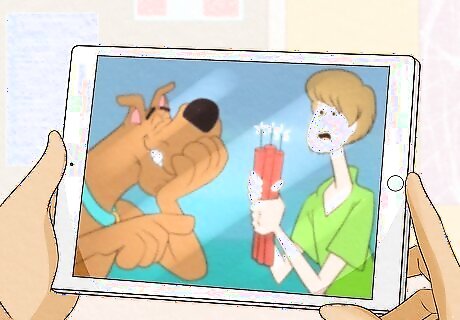
Watch some 1970s kid's cartoons. After school and homework, watch some cartoons that were popular in the 1970s decade to see what things kids watched back then. See if your TV still airs 1970s cartoons. If it only airs more recent cartoons, try YouTube, Netflix, or another streaming service. If you're not interested in watching cartoons anymore, don't worry! Be a 1970s kid in other ways, such as dressing like one or sharing similar experiences. Scooby-Doo, Where Are You! (1969-1978) The Pink Panther Show (1969-1978) Josie and the Pussycats (1970-1971) The Amazing Chan and the Chan Clan (September 1972-December 1972) The Flintstone Comedy Hour (1972-1974) Fat Albert and the Cosby Kids (1972-1984) Butch Cassidy (September 1973-December 1973) Yogi's Gang (September 1973-December 1973) Schoolhouse Rock (1973-2009) Partridge Family 2200 A.D. (September 1974-December 1974) The Tom and Jerry Show (September 1975- December 1975) Jabberjaw (September 1976-December 1976) 3000 Leagues in Search of Mother (January 1976-December 1976) Dynomutt, Dog Wonder (1976-1977) Fred Flintstone and Friends (1977-1978) A kockásfülű nyúl/The Checker-Eared Rabbit (1977-1979) Treasure Island (1978-1979) The All-New Popeye Hour (1978-1983) Doraemon (1979-present) NOTE: The old 1973 version of Doraemon has since been lost. The animation studio that made the original Doraemon, Nippon TeleMovie Productions, went bankrupt in 1981, so they sold some cels of the 1973 series. They also destroyed most cels that they used to create the TV series in a fire. No episodes of this exist online, and the few episodes that have been found are very low quality. So, you can only view the more famous 1979 Doraemon series.
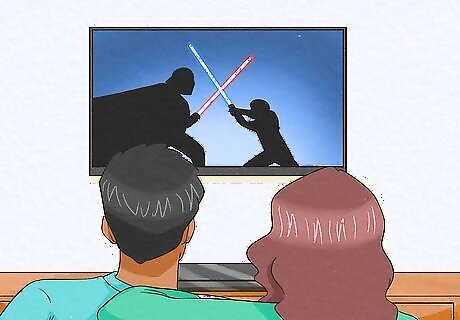
View some 1970s kids' movies. Animated movies had color, but they were still 2D in the 70s. There weren't as many animated movies, and most animated movies were still made by Disney. These include: The Aristocats (1970) The Railway Children (1970) Willy Wonka & the Chocolate Factory (1971) Snoopy, Come Home (1972) A Charlie Brown Thanksgiving (1973) Charlotte's Web (1973) Robin Hood (1973) Benji (1974) Escape to Witch Mountain (1975) Star Wars (1977) - The very first Star Wars series movie! The Hobbit (1977) The Many Adventures of Winnie the Pooh (1977) Superman (1978) The Bugs Bunny/Road Runner Movie (1979) The Muppet Movie (1979)
In Experiences
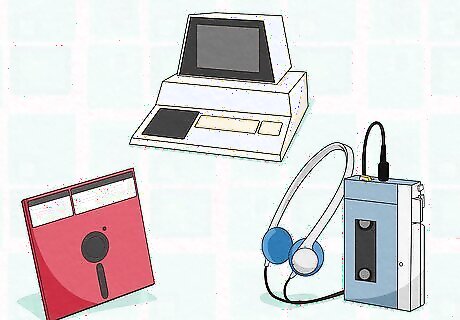
Think about old 1970s technology you used to have. If you were a 1970s kid, think about what types of technology existed. The 1970s marked the early development of modern technology, such as home electronics, video games, and computers. If you weren't a 1970s kid, research about the types of technology. If you still have some, find them and see if they still work. 1970s cathode ray tube televisions Apple II (stylized apple ][) computers Film cameras made by companies such as Canon, Minolta, and Pentax. The Canon AE-1 and the Pentax ME were examples of popular cameras people used in the 70s. Commodore PET computers Floppy disks. Many web processors like Microsoft Word still have the floppy disk as their "Save" icon! Sony Walkman
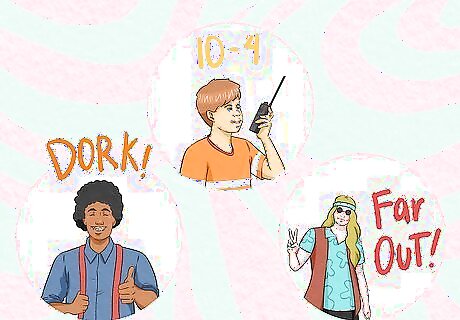
Use 1970s slang. Each decade has its special phrases and slang. The 1970s were no different. There were many phrases that people across the internet used. Some of these include: 10-4/10-4, good buddy - radio code for "Message received"; later added "good buddy" to the term to mean "Ok" Boogie - to dance Brick house - an attractive, strong woman Cool beans - that's cool/great Dork - nerd Far out - radical or cool Groovy - excellent or cool Shaggin’ wagon - a 1970s party van Skinny - the whole truth Space cadet - someone who uses drugs and detached from reality The Man - a boring authority figure (e.g., a teacher, a parent, a relative) You jivin' yet? - asking someone "Are you enjoying it yet?"
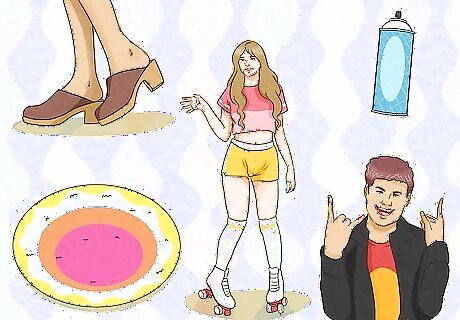
Do 1970s trends. Each modern decade has its many trends. The 1970s trends, fads, and experiences were defined by TV shows, pop culture, cartoons, and shared experiences. Movies and music also influenced the casual fashion and trends of the 1970s. Wear clogs. Clogs are wooden shoes, but many people tend to think of clogs from the Netherlands. They are part of the Dutch traditional folk costume, but people in the 1970s wore them with bell-bottoms or hippie clothing. Jog. Jogging was a trend in the 1970s when people started to exercise for health and wellness. Before WWII, jogging was seen as weird. But following the years after WWII, jogging became popular. Many famous people started jogging. Even then- U.S. president Jimmy Carter started running. Become a fan of heavy metal. Heavy metal music was appreciated in the 1970s. Bands like Led Zeppelin, Iron Butterfly, Queen, and AC/DC produced many iconic heavy metal albums and songs. Become a fan of rock and roll. Rock-and-roll was also a popular music genre in the 1970s. Bands like Kiss, The Rolling Stones, The Beatles, Eagles, ABBA, and Europe made many iconic rock-and-roll albums and songs. Roller skate. Roller skating was a fad in the 1970s. The disco trend influenced roller skating because disco was a rink-friendly dance that you could dance to in roller skates. Go to skating rinks and learn how to roller skate if you don't know how to yet.
Think about other 1970s childhood experiences. Obviously, everyone has a different childhood experience, but there are some parts of the 70s that many people shared. Reminisce about your cool childhood in the 1970s if you grew up during that decade. There are many stores from the 1970s that have closed down. Also, modern technology did not encompass people's whole lives back then; life seemed simpler before the 21st century. Remembering the widespread acceptance of smoking. Back then, it was normal for adults to smoke. There were designated section in stores and restaurants for people to smoke. Now, people know the health risks of smoking, so this does not exist anymore. Being one of the last generations to use a rotary dial telephone. Also, using phonebooks to search up phone numbers instead of having the person's phone number in your contacts list. Using the Dewey Decimal System to find books at the library without the help of the internet. Doing fun activities with your friends outside (e.g. racing bikes, catching insects/frogs, playing backyard games, playing in a treehouse, building things) and not having any restrictions on safety. This was very common in the 70s and 80s; parents on these kids had relaxed rules on safety, and they would just ask them to come back before nighttime or mealtime. Developing photos from companies such as Kodak. No snapping pics from your phone- you used a camera to take a picture, and you had to go to a photo development center to wait for the pictures to process.




















Comments
0 comment